BUS503 Principles of Commercial Law: Analyzing Contractual Issues
VerifiedAdded on 2023/06/13
|10
|3303
|256
Case Study
AI Summary
This case study examines a scenario where Rafia, an event manager at the University of the Sunshine Coast (USC), contracts with Kalpana for a dance performance. The central issue revolves around an oral assurance made by Kalpana regarding the dance form being a traditional, classical Indian dance, which was not explicitly stated in the written contract. The analysis delves into whether this oral assurance forms part of the contract, exploring the Parole Evidence Rule and exceptions such as partly written and partly oral contracts. It further discusses whether the oral assurance should be considered a condition or a warranty, examining collateral contracts and relevant case laws. Finally, the study addresses potential remedies available to USC in the event of a breach of contract, considering damages, liquidated claims, specific performance, and injunctions. The document refers to multiple case laws to support its arguments and conclusions, providing a comprehensive legal analysis of the situation.
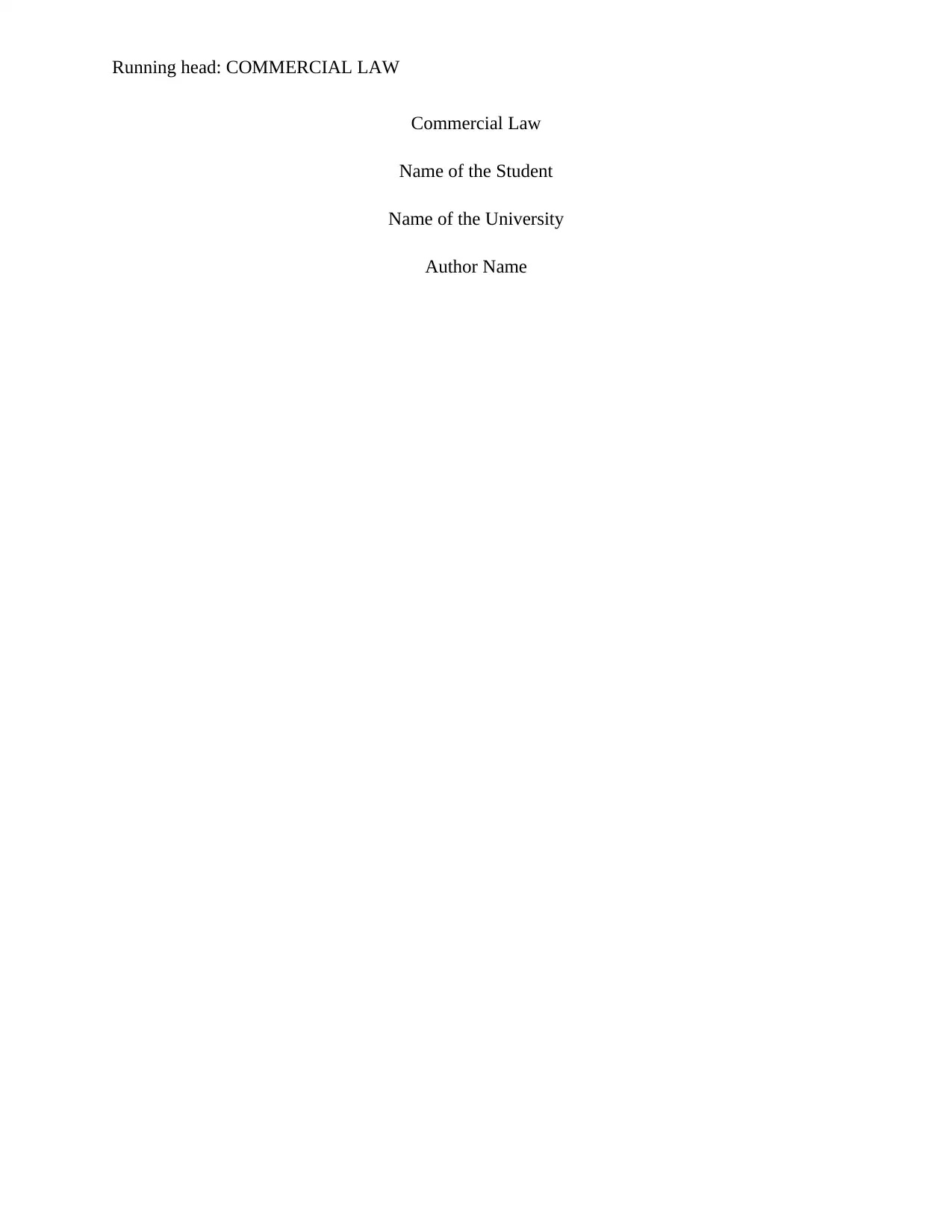
Running head: COMMERCIAL LAW
Commercial Law
Name of the Student
Name of the University
Author Name
Commercial Law
Name of the Student
Name of the University
Author Name
Paraphrase This Document
Need a fresh take? Get an instant paraphrase of this document with our AI Paraphraser
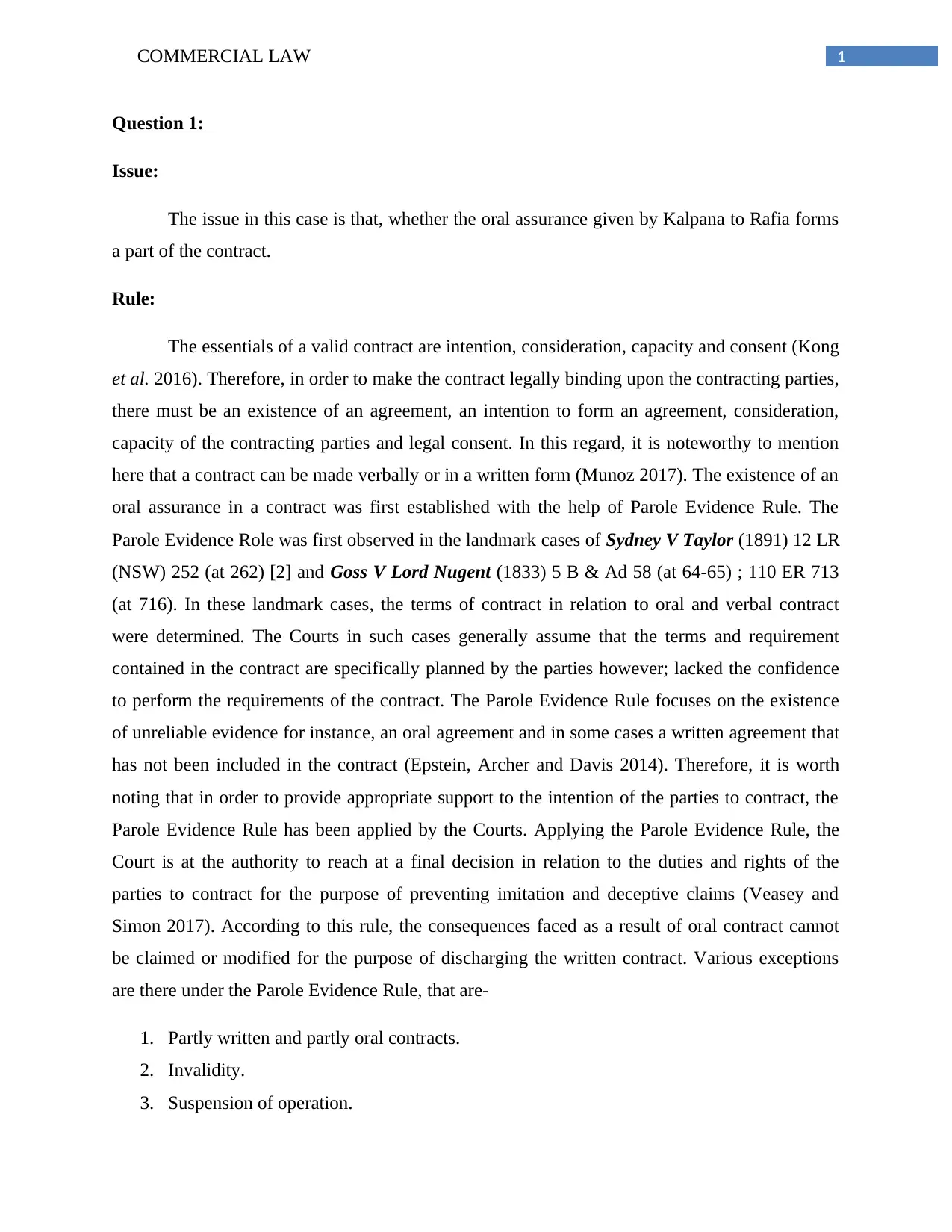
1COMMERCIAL LAW
Question 1:
Issue:
The issue in this case is that, whether the oral assurance given by Kalpana to Rafia forms
a part of the contract.
Rule:
The essentials of a valid contract are intention, consideration, capacity and consent (Kong
et al. 2016). Therefore, in order to make the contract legally binding upon the contracting parties,
there must be an existence of an agreement, an intention to form an agreement, consideration,
capacity of the contracting parties and legal consent. In this regard, it is noteworthy to mention
here that a contract can be made verbally or in a written form (Munoz 2017). The existence of an
oral assurance in a contract was first established with the help of Parole Evidence Rule. The
Parole Evidence Role was first observed in the landmark cases of Sydney V Taylor (1891) 12 LR
(NSW) 252 (at 262) [2] and Goss V Lord Nugent (1833) 5 B & Ad 58 (at 64-65) ; 110 ER 713
(at 716). In these landmark cases, the terms of contract in relation to oral and verbal contract
were determined. The Courts in such cases generally assume that the terms and requirement
contained in the contract are specifically planned by the parties however; lacked the confidence
to perform the requirements of the contract. The Parole Evidence Rule focuses on the existence
of unreliable evidence for instance, an oral agreement and in some cases a written agreement that
has not been included in the contract (Epstein, Archer and Davis 2014). Therefore, it is worth
noting that in order to provide appropriate support to the intention of the parties to contract, the
Parole Evidence Rule has been applied by the Courts. Applying the Parole Evidence Rule, the
Court is at the authority to reach at a final decision in relation to the duties and rights of the
parties to contract for the purpose of preventing imitation and deceptive claims (Veasey and
Simon 2017). According to this rule, the consequences faced as a result of oral contract cannot
be claimed or modified for the purpose of discharging the written contract. Various exceptions
are there under the Parole Evidence Rule, that are-
1. Partly written and partly oral contracts.
2. Invalidity.
3. Suspension of operation.
Question 1:
Issue:
The issue in this case is that, whether the oral assurance given by Kalpana to Rafia forms
a part of the contract.
Rule:
The essentials of a valid contract are intention, consideration, capacity and consent (Kong
et al. 2016). Therefore, in order to make the contract legally binding upon the contracting parties,
there must be an existence of an agreement, an intention to form an agreement, consideration,
capacity of the contracting parties and legal consent. In this regard, it is noteworthy to mention
here that a contract can be made verbally or in a written form (Munoz 2017). The existence of an
oral assurance in a contract was first established with the help of Parole Evidence Rule. The
Parole Evidence Role was first observed in the landmark cases of Sydney V Taylor (1891) 12 LR
(NSW) 252 (at 262) [2] and Goss V Lord Nugent (1833) 5 B & Ad 58 (at 64-65) ; 110 ER 713
(at 716). In these landmark cases, the terms of contract in relation to oral and verbal contract
were determined. The Courts in such cases generally assume that the terms and requirement
contained in the contract are specifically planned by the parties however; lacked the confidence
to perform the requirements of the contract. The Parole Evidence Rule focuses on the existence
of unreliable evidence for instance, an oral agreement and in some cases a written agreement that
has not been included in the contract (Epstein, Archer and Davis 2014). Therefore, it is worth
noting that in order to provide appropriate support to the intention of the parties to contract, the
Parole Evidence Rule has been applied by the Courts. Applying the Parole Evidence Rule, the
Court is at the authority to reach at a final decision in relation to the duties and rights of the
parties to contract for the purpose of preventing imitation and deceptive claims (Veasey and
Simon 2017). According to this rule, the consequences faced as a result of oral contract cannot
be claimed or modified for the purpose of discharging the written contract. Various exceptions
are there under the Parole Evidence Rule, that are-
1. Partly written and partly oral contracts.
2. Invalidity.
3. Suspension of operation.
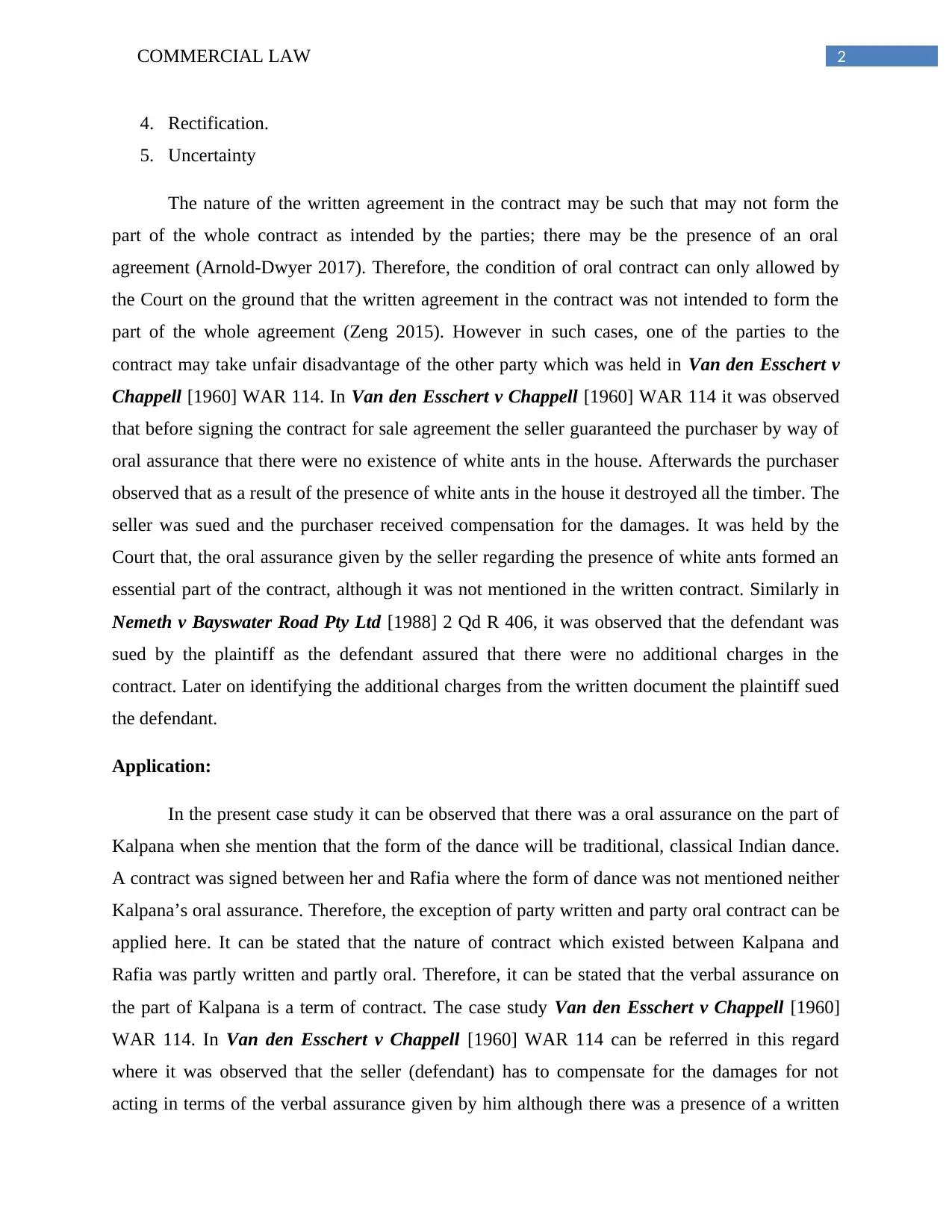
2COMMERCIAL LAW
4. Rectification.
5. Uncertainty
The nature of the written agreement in the contract may be such that may not form the
part of the whole contract as intended by the parties; there may be the presence of an oral
agreement (Arnold‐Dwyer 2017). Therefore, the condition of oral contract can only allowed by
the Court on the ground that the written agreement in the contract was not intended to form the
part of the whole agreement (Zeng 2015). However in such cases, one of the parties to the
contract may take unfair disadvantage of the other party which was held in Van den Esschert v
Chappell [1960] WAR 114. In Van den Esschert v Chappell [1960] WAR 114 it was observed
that before signing the contract for sale agreement the seller guaranteed the purchaser by way of
oral assurance that there were no existence of white ants in the house. Afterwards the purchaser
observed that as a result of the presence of white ants in the house it destroyed all the timber. The
seller was sued and the purchaser received compensation for the damages. It was held by the
Court that, the oral assurance given by the seller regarding the presence of white ants formed an
essential part of the contract, although it was not mentioned in the written contract. Similarly in
Nemeth v Bayswater Road Pty Ltd [1988] 2 Qd R 406, it was observed that the defendant was
sued by the plaintiff as the defendant assured that there were no additional charges in the
contract. Later on identifying the additional charges from the written document the plaintiff sued
the defendant.
Application:
In the present case study it can be observed that there was a oral assurance on the part of
Kalpana when she mention that the form of the dance will be traditional, classical Indian dance.
A contract was signed between her and Rafia where the form of dance was not mentioned neither
Kalpana’s oral assurance. Therefore, the exception of party written and party oral contract can be
applied here. It can be stated that the nature of contract which existed between Kalpana and
Rafia was partly written and partly oral. Therefore, it can be stated that the verbal assurance on
the part of Kalpana is a term of contract. The case study Van den Esschert v Chappell [1960]
WAR 114. In Van den Esschert v Chappell [1960] WAR 114 can be referred in this regard
where it was observed that the seller (defendant) has to compensate for the damages for not
acting in terms of the verbal assurance given by him although there was a presence of a written
4. Rectification.
5. Uncertainty
The nature of the written agreement in the contract may be such that may not form the
part of the whole contract as intended by the parties; there may be the presence of an oral
agreement (Arnold‐Dwyer 2017). Therefore, the condition of oral contract can only allowed by
the Court on the ground that the written agreement in the contract was not intended to form the
part of the whole agreement (Zeng 2015). However in such cases, one of the parties to the
contract may take unfair disadvantage of the other party which was held in Van den Esschert v
Chappell [1960] WAR 114. In Van den Esschert v Chappell [1960] WAR 114 it was observed
that before signing the contract for sale agreement the seller guaranteed the purchaser by way of
oral assurance that there were no existence of white ants in the house. Afterwards the purchaser
observed that as a result of the presence of white ants in the house it destroyed all the timber. The
seller was sued and the purchaser received compensation for the damages. It was held by the
Court that, the oral assurance given by the seller regarding the presence of white ants formed an
essential part of the contract, although it was not mentioned in the written contract. Similarly in
Nemeth v Bayswater Road Pty Ltd [1988] 2 Qd R 406, it was observed that the defendant was
sued by the plaintiff as the defendant assured that there were no additional charges in the
contract. Later on identifying the additional charges from the written document the plaintiff sued
the defendant.
Application:
In the present case study it can be observed that there was a oral assurance on the part of
Kalpana when she mention that the form of the dance will be traditional, classical Indian dance.
A contract was signed between her and Rafia where the form of dance was not mentioned neither
Kalpana’s oral assurance. Therefore, the exception of party written and party oral contract can be
applied here. It can be stated that the nature of contract which existed between Kalpana and
Rafia was partly written and partly oral. Therefore, it can be stated that the verbal assurance on
the part of Kalpana is a term of contract. The case study Van den Esschert v Chappell [1960]
WAR 114. In Van den Esschert v Chappell [1960] WAR 114 can be referred in this regard
where it was observed that the seller (defendant) has to compensate for the damages for not
acting in terms of the verbal assurance given by him although there was a presence of a written
⊘ This is a preview!⊘
Do you want full access?
Subscribe today to unlock all pages.

Trusted by 1+ million students worldwide
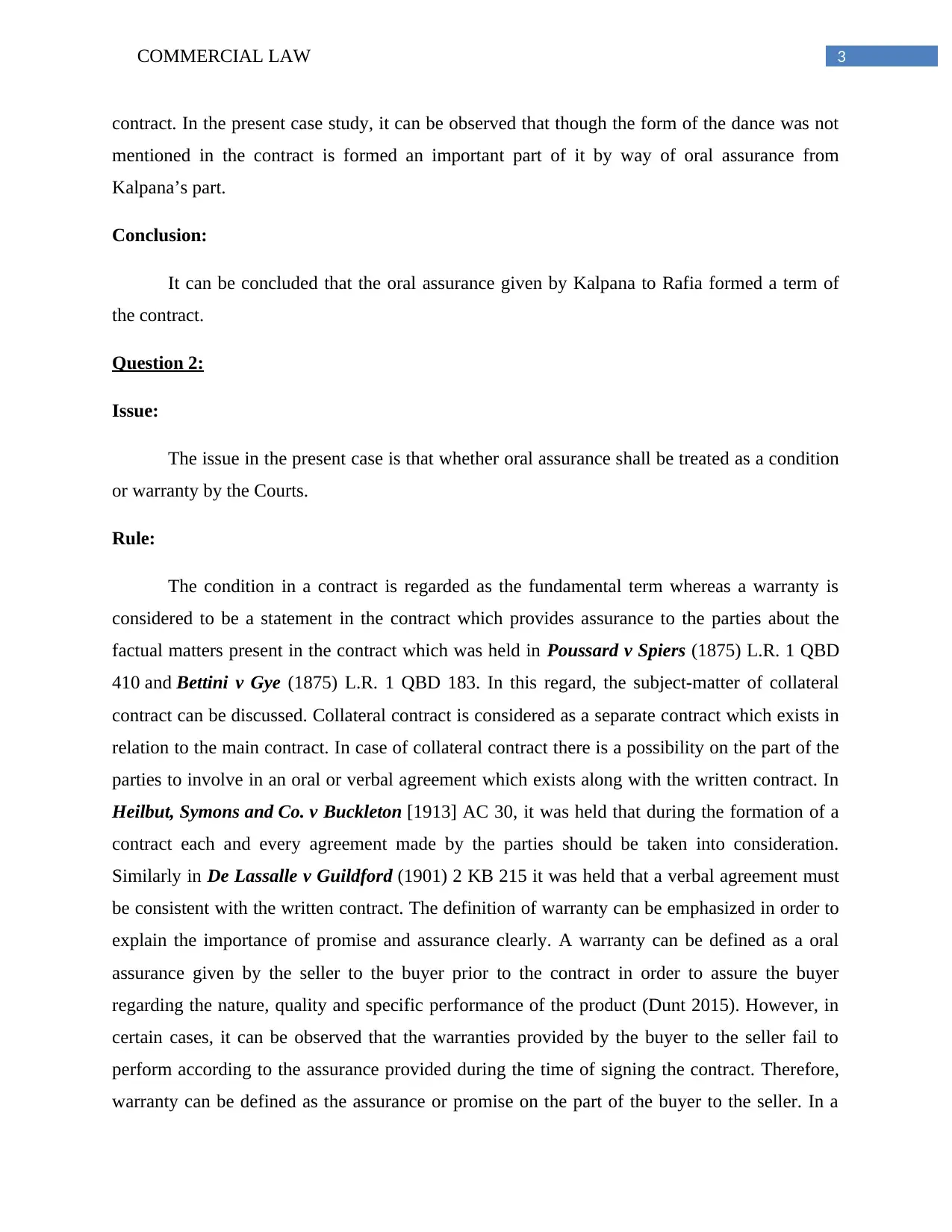
3COMMERCIAL LAW
contract. In the present case study, it can be observed that though the form of the dance was not
mentioned in the contract is formed an important part of it by way of oral assurance from
Kalpana’s part.
Conclusion:
It can be concluded that the oral assurance given by Kalpana to Rafia formed a term of
the contract.
Question 2:
Issue:
The issue in the present case is that whether oral assurance shall be treated as a condition
or warranty by the Courts.
Rule:
The condition in a contract is regarded as the fundamental term whereas a warranty is
considered to be a statement in the contract which provides assurance to the parties about the
factual matters present in the contract which was held in Poussard v Spiers (1875) L.R. 1 QBD
410 and Bettini v Gye (1875) L.R. 1 QBD 183. In this regard, the subject-matter of collateral
contract can be discussed. Collateral contract is considered as a separate contract which exists in
relation to the main contract. In case of collateral contract there is a possibility on the part of the
parties to involve in an oral or verbal agreement which exists along with the written contract. In
Heilbut, Symons and Co. v Buckleton [1913] AC 30, it was held that during the formation of a
contract each and every agreement made by the parties should be taken into consideration.
Similarly in De Lassalle v Guildford (1901) 2 KB 215 it was held that a verbal agreement must
be consistent with the written contract. The definition of warranty can be emphasized in order to
explain the importance of promise and assurance clearly. A warranty can be defined as a oral
assurance given by the seller to the buyer prior to the contract in order to assure the buyer
regarding the nature, quality and specific performance of the product (Dunt 2015). However, in
certain cases, it can be observed that the warranties provided by the buyer to the seller fail to
perform according to the assurance provided during the time of signing the contract. Therefore,
warranty can be defined as the assurance or promise on the part of the buyer to the seller. In a
contract. In the present case study, it can be observed that though the form of the dance was not
mentioned in the contract is formed an important part of it by way of oral assurance from
Kalpana’s part.
Conclusion:
It can be concluded that the oral assurance given by Kalpana to Rafia formed a term of
the contract.
Question 2:
Issue:
The issue in the present case is that whether oral assurance shall be treated as a condition
or warranty by the Courts.
Rule:
The condition in a contract is regarded as the fundamental term whereas a warranty is
considered to be a statement in the contract which provides assurance to the parties about the
factual matters present in the contract which was held in Poussard v Spiers (1875) L.R. 1 QBD
410 and Bettini v Gye (1875) L.R. 1 QBD 183. In this regard, the subject-matter of collateral
contract can be discussed. Collateral contract is considered as a separate contract which exists in
relation to the main contract. In case of collateral contract there is a possibility on the part of the
parties to involve in an oral or verbal agreement which exists along with the written contract. In
Heilbut, Symons and Co. v Buckleton [1913] AC 30, it was held that during the formation of a
contract each and every agreement made by the parties should be taken into consideration.
Similarly in De Lassalle v Guildford (1901) 2 KB 215 it was held that a verbal agreement must
be consistent with the written contract. The definition of warranty can be emphasized in order to
explain the importance of promise and assurance clearly. A warranty can be defined as a oral
assurance given by the seller to the buyer prior to the contract in order to assure the buyer
regarding the nature, quality and specific performance of the product (Dunt 2015). However, in
certain cases, it can be observed that the warranties provided by the buyer to the seller fail to
perform according to the assurance provided during the time of signing the contract. Therefore,
warranty can be defined as the assurance or promise on the part of the buyer to the seller. In a
Paraphrase This Document
Need a fresh take? Get an instant paraphrase of this document with our AI Paraphraser
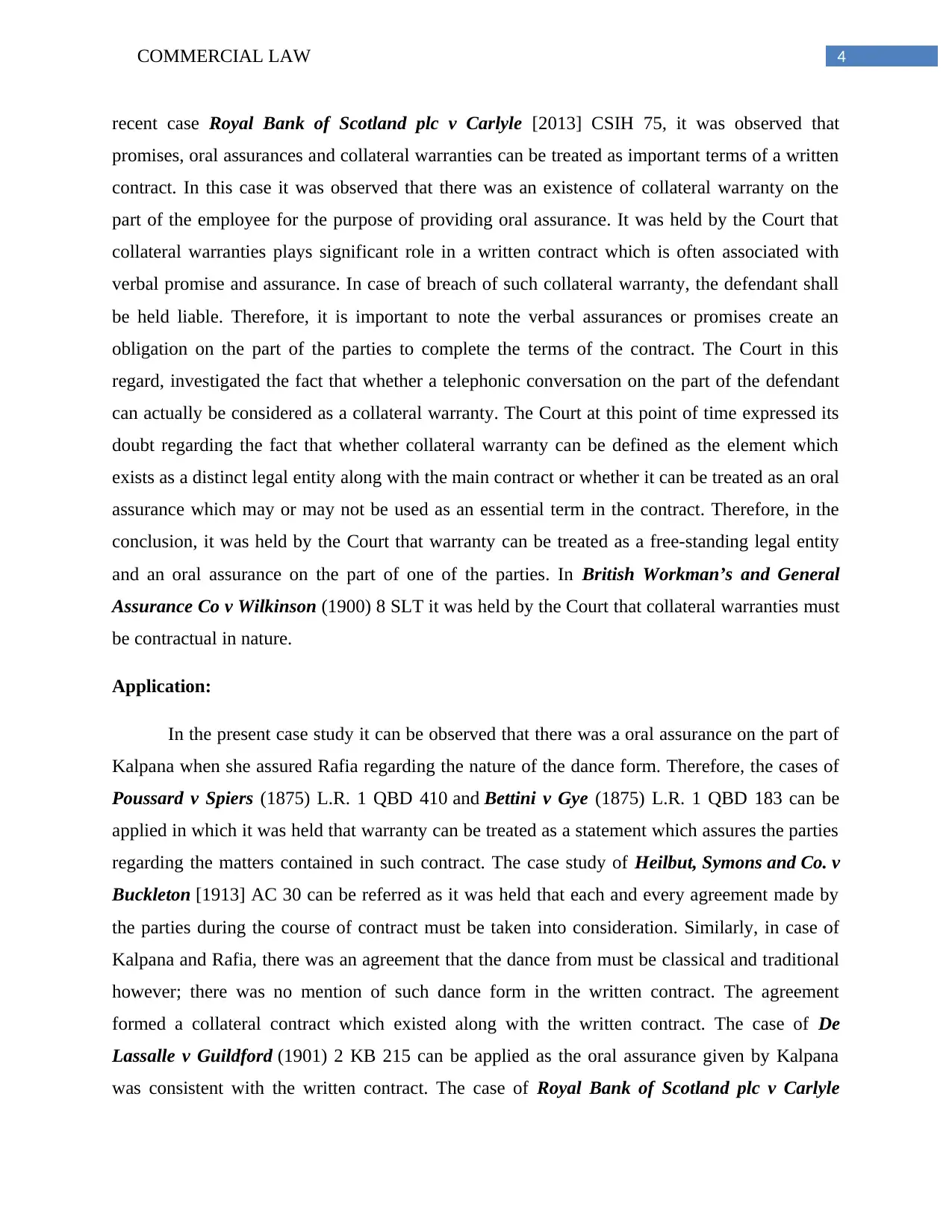
4COMMERCIAL LAW
recent case Royal Bank of Scotland plc v Carlyle [2013] CSIH 75, it was observed that
promises, oral assurances and collateral warranties can be treated as important terms of a written
contract. In this case it was observed that there was an existence of collateral warranty on the
part of the employee for the purpose of providing oral assurance. It was held by the Court that
collateral warranties plays significant role in a written contract which is often associated with
verbal promise and assurance. In case of breach of such collateral warranty, the defendant shall
be held liable. Therefore, it is important to note the verbal assurances or promises create an
obligation on the part of the parties to complete the terms of the contract. The Court in this
regard, investigated the fact that whether a telephonic conversation on the part of the defendant
can actually be considered as a collateral warranty. The Court at this point of time expressed its
doubt regarding the fact that whether collateral warranty can be defined as the element which
exists as a distinct legal entity along with the main contract or whether it can be treated as an oral
assurance which may or may not be used as an essential term in the contract. Therefore, in the
conclusion, it was held by the Court that warranty can be treated as a free-standing legal entity
and an oral assurance on the part of one of the parties. In British Workman’s and General
Assurance Co v Wilkinson (1900) 8 SLT it was held by the Court that collateral warranties must
be contractual in nature.
Application:
In the present case study it can be observed that there was a oral assurance on the part of
Kalpana when she assured Rafia regarding the nature of the dance form. Therefore, the cases of
Poussard v Spiers (1875) L.R. 1 QBD 410 and Bettini v Gye (1875) L.R. 1 QBD 183 can be
applied in which it was held that warranty can be treated as a statement which assures the parties
regarding the matters contained in such contract. The case study of Heilbut, Symons and Co. v
Buckleton [1913] AC 30 can be referred as it was held that each and every agreement made by
the parties during the course of contract must be taken into consideration. Similarly, in case of
Kalpana and Rafia, there was an agreement that the dance from must be classical and traditional
however; there was no mention of such dance form in the written contract. The agreement
formed a collateral contract which existed along with the written contract. The case of De
Lassalle v Guildford (1901) 2 KB 215 can be applied as the oral assurance given by Kalpana
was consistent with the written contract. The case of Royal Bank of Scotland plc v Carlyle
recent case Royal Bank of Scotland plc v Carlyle [2013] CSIH 75, it was observed that
promises, oral assurances and collateral warranties can be treated as important terms of a written
contract. In this case it was observed that there was an existence of collateral warranty on the
part of the employee for the purpose of providing oral assurance. It was held by the Court that
collateral warranties plays significant role in a written contract which is often associated with
verbal promise and assurance. In case of breach of such collateral warranty, the defendant shall
be held liable. Therefore, it is important to note the verbal assurances or promises create an
obligation on the part of the parties to complete the terms of the contract. The Court in this
regard, investigated the fact that whether a telephonic conversation on the part of the defendant
can actually be considered as a collateral warranty. The Court at this point of time expressed its
doubt regarding the fact that whether collateral warranty can be defined as the element which
exists as a distinct legal entity along with the main contract or whether it can be treated as an oral
assurance which may or may not be used as an essential term in the contract. Therefore, in the
conclusion, it was held by the Court that warranty can be treated as a free-standing legal entity
and an oral assurance on the part of one of the parties. In British Workman’s and General
Assurance Co v Wilkinson (1900) 8 SLT it was held by the Court that collateral warranties must
be contractual in nature.
Application:
In the present case study it can be observed that there was a oral assurance on the part of
Kalpana when she assured Rafia regarding the nature of the dance form. Therefore, the cases of
Poussard v Spiers (1875) L.R. 1 QBD 410 and Bettini v Gye (1875) L.R. 1 QBD 183 can be
applied in which it was held that warranty can be treated as a statement which assures the parties
regarding the matters contained in such contract. The case study of Heilbut, Symons and Co. v
Buckleton [1913] AC 30 can be referred as it was held that each and every agreement made by
the parties during the course of contract must be taken into consideration. Similarly, in case of
Kalpana and Rafia, there was an agreement that the dance from must be classical and traditional
however; there was no mention of such dance form in the written contract. The agreement
formed a collateral contract which existed along with the written contract. The case of De
Lassalle v Guildford (1901) 2 KB 215 can be applied as the oral assurance given by Kalpana
was consistent with the written contract. The case of Royal Bank of Scotland plc v Carlyle
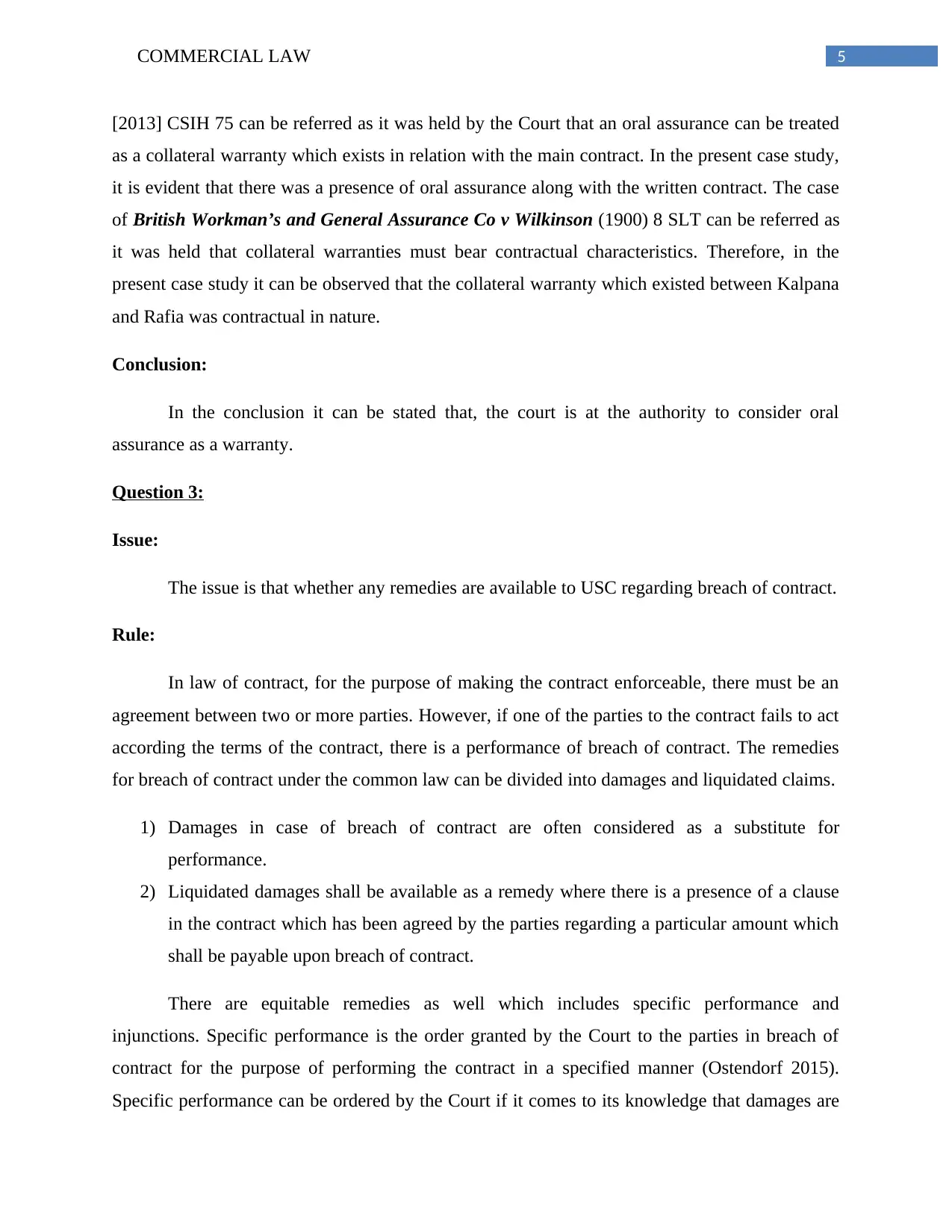
5COMMERCIAL LAW
[2013] CSIH 75 can be referred as it was held by the Court that an oral assurance can be treated
as a collateral warranty which exists in relation with the main contract. In the present case study,
it is evident that there was a presence of oral assurance along with the written contract. The case
of British Workman’s and General Assurance Co v Wilkinson (1900) 8 SLT can be referred as
it was held that collateral warranties must bear contractual characteristics. Therefore, in the
present case study it can be observed that the collateral warranty which existed between Kalpana
and Rafia was contractual in nature.
Conclusion:
In the conclusion it can be stated that, the court is at the authority to consider oral
assurance as a warranty.
Question 3:
Issue:
The issue is that whether any remedies are available to USC regarding breach of contract.
Rule:
In law of contract, for the purpose of making the contract enforceable, there must be an
agreement between two or more parties. However, if one of the parties to the contract fails to act
according the terms of the contract, there is a performance of breach of contract. The remedies
for breach of contract under the common law can be divided into damages and liquidated claims.
1) Damages in case of breach of contract are often considered as a substitute for
performance.
2) Liquidated damages shall be available as a remedy where there is a presence of a clause
in the contract which has been agreed by the parties regarding a particular amount which
shall be payable upon breach of contract.
There are equitable remedies as well which includes specific performance and
injunctions. Specific performance is the order granted by the Court to the parties in breach of
contract for the purpose of performing the contract in a specified manner (Ostendorf 2015).
Specific performance can be ordered by the Court if it comes to its knowledge that damages are
[2013] CSIH 75 can be referred as it was held by the Court that an oral assurance can be treated
as a collateral warranty which exists in relation with the main contract. In the present case study,
it is evident that there was a presence of oral assurance along with the written contract. The case
of British Workman’s and General Assurance Co v Wilkinson (1900) 8 SLT can be referred as
it was held that collateral warranties must bear contractual characteristics. Therefore, in the
present case study it can be observed that the collateral warranty which existed between Kalpana
and Rafia was contractual in nature.
Conclusion:
In the conclusion it can be stated that, the court is at the authority to consider oral
assurance as a warranty.
Question 3:
Issue:
The issue is that whether any remedies are available to USC regarding breach of contract.
Rule:
In law of contract, for the purpose of making the contract enforceable, there must be an
agreement between two or more parties. However, if one of the parties to the contract fails to act
according the terms of the contract, there is a performance of breach of contract. The remedies
for breach of contract under the common law can be divided into damages and liquidated claims.
1) Damages in case of breach of contract are often considered as a substitute for
performance.
2) Liquidated damages shall be available as a remedy where there is a presence of a clause
in the contract which has been agreed by the parties regarding a particular amount which
shall be payable upon breach of contract.
There are equitable remedies as well which includes specific performance and
injunctions. Specific performance is the order granted by the Court to the parties in breach of
contract for the purpose of performing the contract in a specified manner (Ostendorf 2015).
Specific performance can be ordered by the Court if it comes to its knowledge that damages are
⊘ This is a preview!⊘
Do you want full access?
Subscribe today to unlock all pages.

Trusted by 1+ million students worldwide
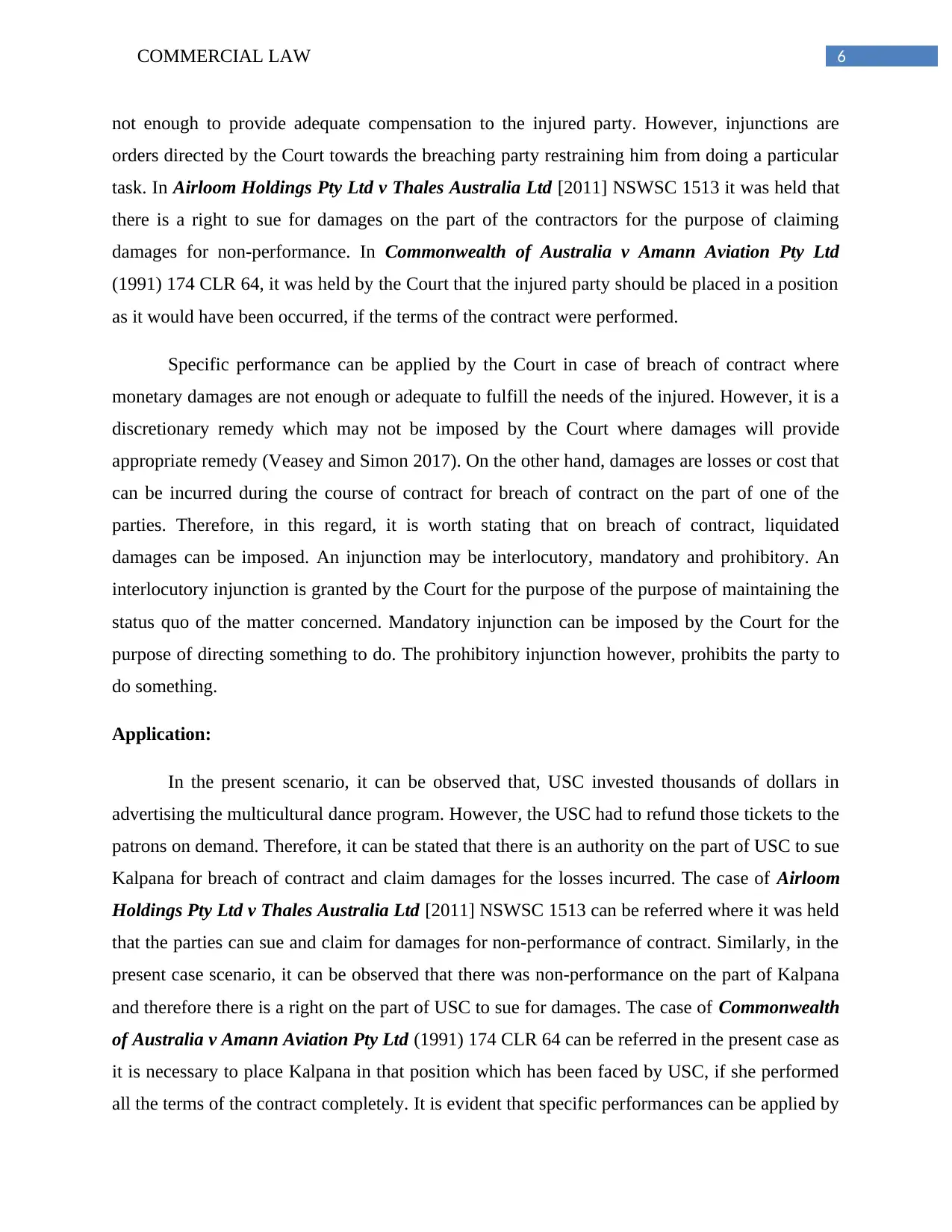
6COMMERCIAL LAW
not enough to provide adequate compensation to the injured party. However, injunctions are
orders directed by the Court towards the breaching party restraining him from doing a particular
task. In Airloom Holdings Pty Ltd v Thales Australia Ltd [2011] NSWSC 1513 it was held that
there is a right to sue for damages on the part of the contractors for the purpose of claiming
damages for non-performance. In Commonwealth of Australia v Amann Aviation Pty Ltd
(1991) 174 CLR 64, it was held by the Court that the injured party should be placed in a position
as it would have been occurred, if the terms of the contract were performed.
Specific performance can be applied by the Court in case of breach of contract where
monetary damages are not enough or adequate to fulfill the needs of the injured. However, it is a
discretionary remedy which may not be imposed by the Court where damages will provide
appropriate remedy (Veasey and Simon 2017). On the other hand, damages are losses or cost that
can be incurred during the course of contract for breach of contract on the part of one of the
parties. Therefore, in this regard, it is worth stating that on breach of contract, liquidated
damages can be imposed. An injunction may be interlocutory, mandatory and prohibitory. An
interlocutory injunction is granted by the Court for the purpose of the purpose of maintaining the
status quo of the matter concerned. Mandatory injunction can be imposed by the Court for the
purpose of directing something to do. The prohibitory injunction however, prohibits the party to
do something.
Application:
In the present scenario, it can be observed that, USC invested thousands of dollars in
advertising the multicultural dance program. However, the USC had to refund those tickets to the
patrons on demand. Therefore, it can be stated that there is an authority on the part of USC to sue
Kalpana for breach of contract and claim damages for the losses incurred. The case of Airloom
Holdings Pty Ltd v Thales Australia Ltd [2011] NSWSC 1513 can be referred where it was held
that the parties can sue and claim for damages for non-performance of contract. Similarly, in the
present case scenario, it can be observed that there was non-performance on the part of Kalpana
and therefore there is a right on the part of USC to sue for damages. The case of Commonwealth
of Australia v Amann Aviation Pty Ltd (1991) 174 CLR 64 can be referred in the present case as
it is necessary to place Kalpana in that position which has been faced by USC, if she performed
all the terms of the contract completely. It is evident that specific performances can be applied by
not enough to provide adequate compensation to the injured party. However, injunctions are
orders directed by the Court towards the breaching party restraining him from doing a particular
task. In Airloom Holdings Pty Ltd v Thales Australia Ltd [2011] NSWSC 1513 it was held that
there is a right to sue for damages on the part of the contractors for the purpose of claiming
damages for non-performance. In Commonwealth of Australia v Amann Aviation Pty Ltd
(1991) 174 CLR 64, it was held by the Court that the injured party should be placed in a position
as it would have been occurred, if the terms of the contract were performed.
Specific performance can be applied by the Court in case of breach of contract where
monetary damages are not enough or adequate to fulfill the needs of the injured. However, it is a
discretionary remedy which may not be imposed by the Court where damages will provide
appropriate remedy (Veasey and Simon 2017). On the other hand, damages are losses or cost that
can be incurred during the course of contract for breach of contract on the part of one of the
parties. Therefore, in this regard, it is worth stating that on breach of contract, liquidated
damages can be imposed. An injunction may be interlocutory, mandatory and prohibitory. An
interlocutory injunction is granted by the Court for the purpose of the purpose of maintaining the
status quo of the matter concerned. Mandatory injunction can be imposed by the Court for the
purpose of directing something to do. The prohibitory injunction however, prohibits the party to
do something.
Application:
In the present scenario, it can be observed that, USC invested thousands of dollars in
advertising the multicultural dance program. However, the USC had to refund those tickets to the
patrons on demand. Therefore, it can be stated that there is an authority on the part of USC to sue
Kalpana for breach of contract and claim damages for the losses incurred. The case of Airloom
Holdings Pty Ltd v Thales Australia Ltd [2011] NSWSC 1513 can be referred where it was held
that the parties can sue and claim for damages for non-performance of contract. Similarly, in the
present case scenario, it can be observed that there was non-performance on the part of Kalpana
and therefore there is a right on the part of USC to sue for damages. The case of Commonwealth
of Australia v Amann Aviation Pty Ltd (1991) 174 CLR 64 can be referred in the present case as
it is necessary to place Kalpana in that position which has been faced by USC, if she performed
all the terms of the contract completely. It is evident that specific performances can be applied by
Paraphrase This Document
Need a fresh take? Get an instant paraphrase of this document with our AI Paraphraser
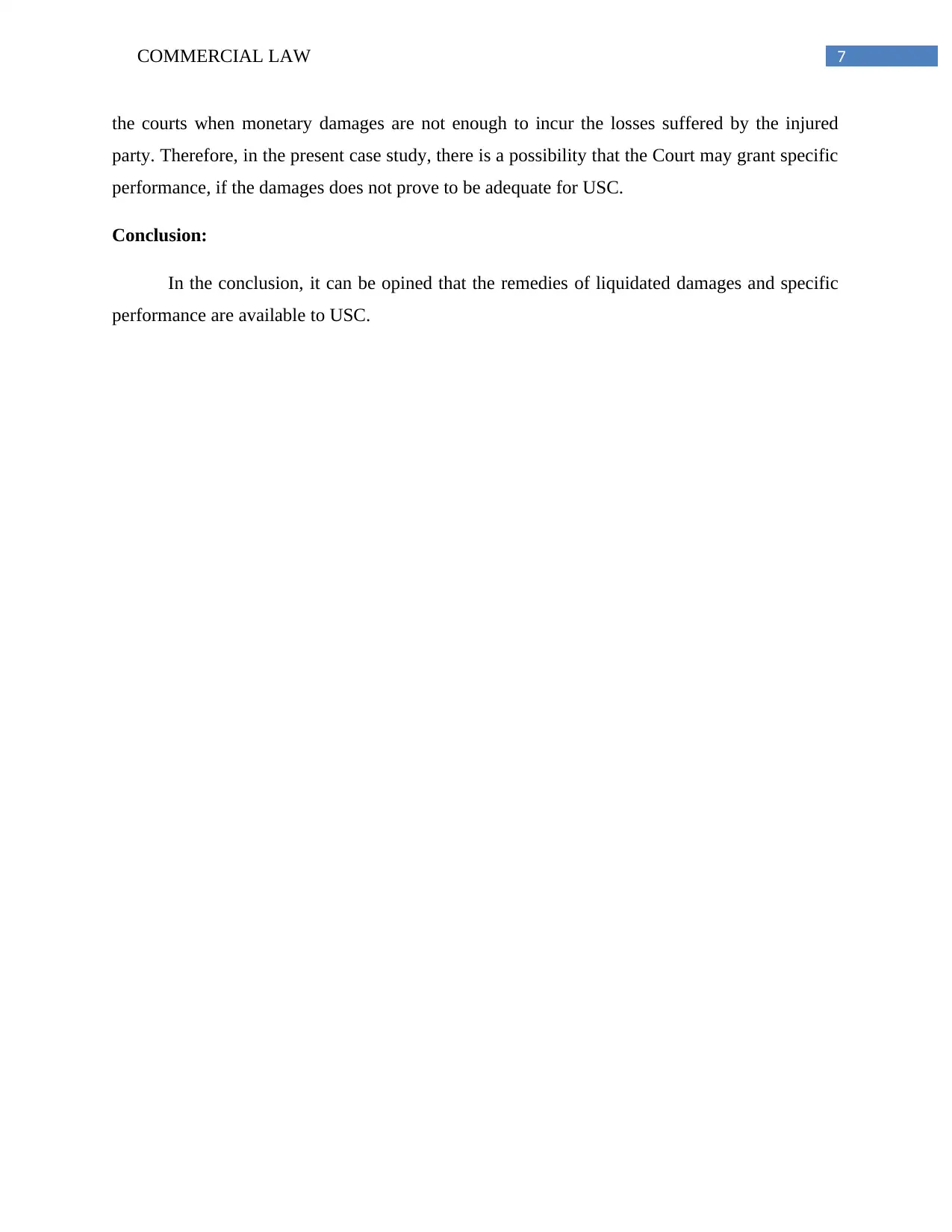
7COMMERCIAL LAW
the courts when monetary damages are not enough to incur the losses suffered by the injured
party. Therefore, in the present case study, there is a possibility that the Court may grant specific
performance, if the damages does not prove to be adequate for USC.
Conclusion:
In the conclusion, it can be opined that the remedies of liquidated damages and specific
performance are available to USC.
the courts when monetary damages are not enough to incur the losses suffered by the injured
party. Therefore, in the present case study, there is a possibility that the Court may grant specific
performance, if the damages does not prove to be adequate for USC.
Conclusion:
In the conclusion, it can be opined that the remedies of liquidated damages and specific
performance are available to USC.
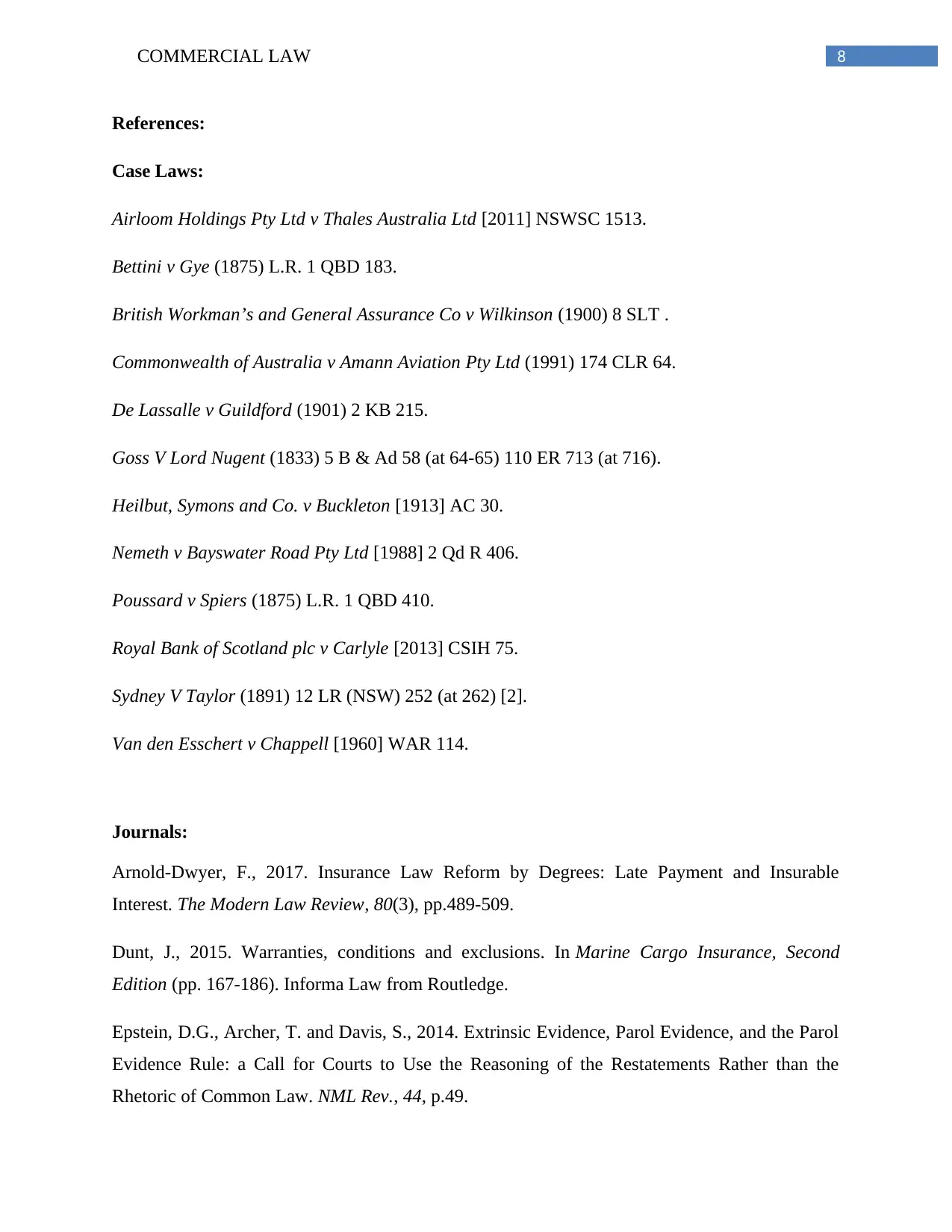
8COMMERCIAL LAW
References:
Case Laws:
Airloom Holdings Pty Ltd v Thales Australia Ltd [2011] NSWSC 1513.
Bettini v Gye (1875) L.R. 1 QBD 183.
British Workman’s and General Assurance Co v Wilkinson (1900) 8 SLT .
Commonwealth of Australia v Amann Aviation Pty Ltd (1991) 174 CLR 64.
De Lassalle v Guildford (1901) 2 KB 215.
Goss V Lord Nugent (1833) 5 B & Ad 58 (at 64-65) 110 ER 713 (at 716).
Heilbut, Symons and Co. v Buckleton [1913] AC 30.
Nemeth v Bayswater Road Pty Ltd [1988] 2 Qd R 406.
Poussard v Spiers (1875) L.R. 1 QBD 410.
Royal Bank of Scotland plc v Carlyle [2013] CSIH 75.
Sydney V Taylor (1891) 12 LR (NSW) 252 (at 262) [2].
Van den Esschert v Chappell [1960] WAR 114.
Journals:
Arnold‐Dwyer, F., 2017. Insurance Law Reform by Degrees: Late Payment and Insurable
Interest. The Modern Law Review, 80(3), pp.489-509.
Dunt, J., 2015. Warranties, conditions and exclusions. In Marine Cargo Insurance, Second
Edition (pp. 167-186). Informa Law from Routledge.
Epstein, D.G., Archer, T. and Davis, S., 2014. Extrinsic Evidence, Parol Evidence, and the Parol
Evidence Rule: a Call for Courts to Use the Reasoning of the Restatements Rather than the
Rhetoric of Common Law. NML Rev., 44, p.49.
References:
Case Laws:
Airloom Holdings Pty Ltd v Thales Australia Ltd [2011] NSWSC 1513.
Bettini v Gye (1875) L.R. 1 QBD 183.
British Workman’s and General Assurance Co v Wilkinson (1900) 8 SLT .
Commonwealth of Australia v Amann Aviation Pty Ltd (1991) 174 CLR 64.
De Lassalle v Guildford (1901) 2 KB 215.
Goss V Lord Nugent (1833) 5 B & Ad 58 (at 64-65) 110 ER 713 (at 716).
Heilbut, Symons and Co. v Buckleton [1913] AC 30.
Nemeth v Bayswater Road Pty Ltd [1988] 2 Qd R 406.
Poussard v Spiers (1875) L.R. 1 QBD 410.
Royal Bank of Scotland plc v Carlyle [2013] CSIH 75.
Sydney V Taylor (1891) 12 LR (NSW) 252 (at 262) [2].
Van den Esschert v Chappell [1960] WAR 114.
Journals:
Arnold‐Dwyer, F., 2017. Insurance Law Reform by Degrees: Late Payment and Insurable
Interest. The Modern Law Review, 80(3), pp.489-509.
Dunt, J., 2015. Warranties, conditions and exclusions. In Marine Cargo Insurance, Second
Edition (pp. 167-186). Informa Law from Routledge.
Epstein, D.G., Archer, T. and Davis, S., 2014. Extrinsic Evidence, Parol Evidence, and the Parol
Evidence Rule: a Call for Courts to Use the Reasoning of the Restatements Rather than the
Rhetoric of Common Law. NML Rev., 44, p.49.
⊘ This is a preview!⊘
Do you want full access?
Subscribe today to unlock all pages.

Trusted by 1+ million students worldwide
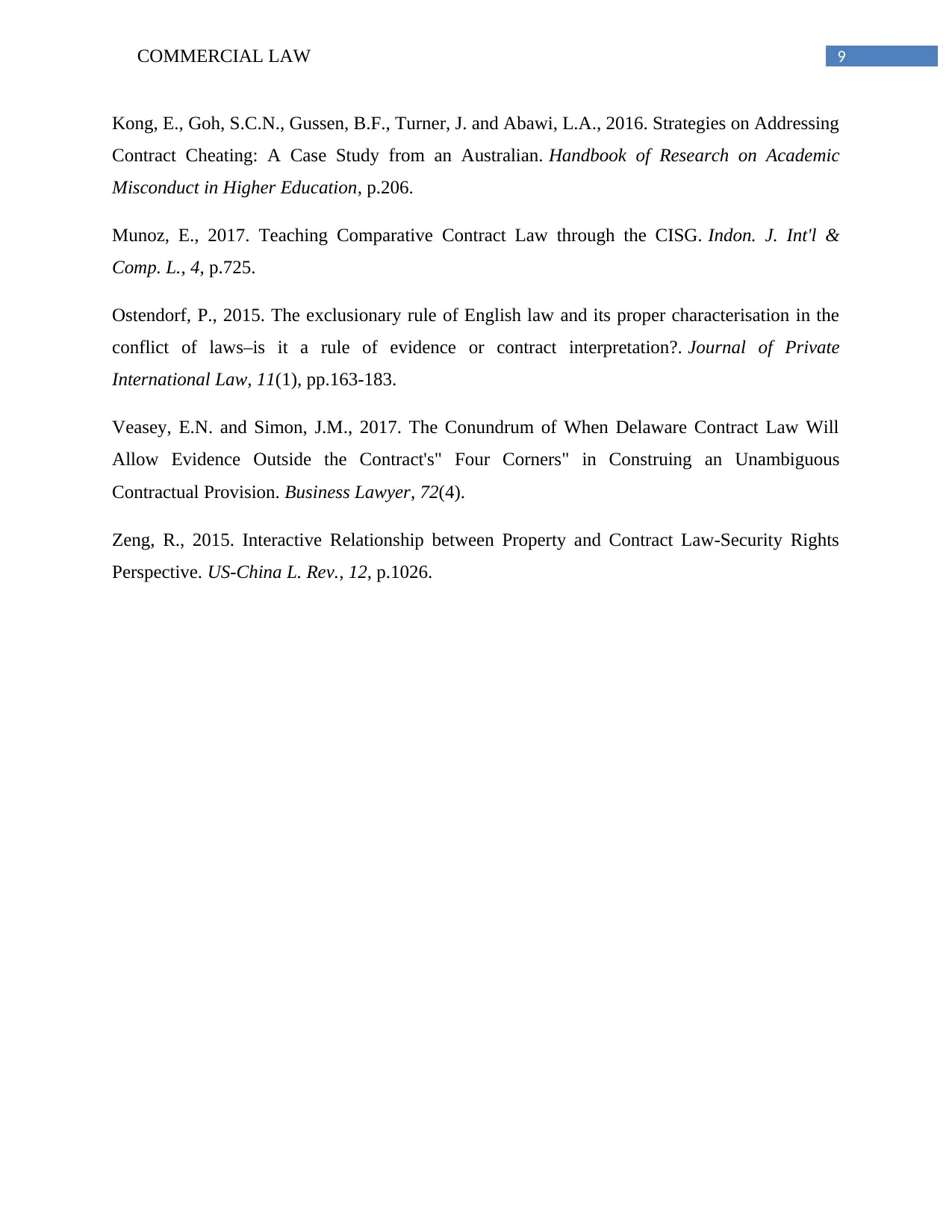
9COMMERCIAL LAW
Kong, E., Goh, S.C.N., Gussen, B.F., Turner, J. and Abawi, L.A., 2016. Strategies on Addressing
Contract Cheating: A Case Study from an Australian. Handbook of Research on Academic
Misconduct in Higher Education, p.206.
Munoz, E., 2017. Teaching Comparative Contract Law through the CISG. Indon. J. Int'l &
Comp. L., 4, p.725.
Ostendorf, P., 2015. The exclusionary rule of English law and its proper characterisation in the
conflict of laws–is it a rule of evidence or contract interpretation?. Journal of Private
International Law, 11(1), pp.163-183.
Veasey, E.N. and Simon, J.M., 2017. The Conundrum of When Delaware Contract Law Will
Allow Evidence Outside the Contract's" Four Corners" in Construing an Unambiguous
Contractual Provision. Business Lawyer, 72(4).
Zeng, R., 2015. Interactive Relationship between Property and Contract Law-Security Rights
Perspective. US-China L. Rev., 12, p.1026.
Kong, E., Goh, S.C.N., Gussen, B.F., Turner, J. and Abawi, L.A., 2016. Strategies on Addressing
Contract Cheating: A Case Study from an Australian. Handbook of Research on Academic
Misconduct in Higher Education, p.206.
Munoz, E., 2017. Teaching Comparative Contract Law through the CISG. Indon. J. Int'l &
Comp. L., 4, p.725.
Ostendorf, P., 2015. The exclusionary rule of English law and its proper characterisation in the
conflict of laws–is it a rule of evidence or contract interpretation?. Journal of Private
International Law, 11(1), pp.163-183.
Veasey, E.N. and Simon, J.M., 2017. The Conundrum of When Delaware Contract Law Will
Allow Evidence Outside the Contract's" Four Corners" in Construing an Unambiguous
Contractual Provision. Business Lawyer, 72(4).
Zeng, R., 2015. Interactive Relationship between Property and Contract Law-Security Rights
Perspective. US-China L. Rev., 12, p.1026.
1 out of 10
Related Documents
Your All-in-One AI-Powered Toolkit for Academic Success.
+13062052269
info@desklib.com
Available 24*7 on WhatsApp / Email
![[object Object]](/_next/static/media/star-bottom.7253800d.svg)
Unlock your academic potential
Copyright © 2020–2025 A2Z Services. All Rights Reserved. Developed and managed by ZUCOL.




